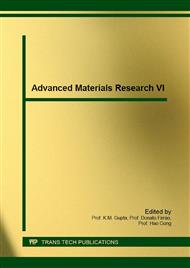[1]
S. S. Prabu, S. Prathiba, A. Sharma, S. Garg, G. Manikandan, C. Sriram: Investigation on adhesive wear behaviour of industrial crystalline and semi-crystalline polymers against steel counter face, International Journal of ChemTech Research, 6, (7), (2014).
Google Scholar
[2]
G. Kalácska: An engineering approach to dry friction behavior of numerous engineering plastics with respect to the mechanical properties, eXPRESS Polymer Letters, 7, (2), (2013), p.199.
DOI: 10.3144/expresspolymlett.2013.18
Google Scholar
[3]
Y. Q. Wang and J. Li, Sliding wear behaviour and mechanism of ultra-high molecular weight polyethylene, Mater Science Engineering, A266, (1999), p.155.
Google Scholar
[4]
M. A. Chowdhury, D. M. Nuruzzaman, A. Kowser, M. Rahman, B. K. Roy, S. Chakraborty, S. Hossen, I. Uddin, S. Hossain: Frictional behaviour of polymers sliding against smooth and rough mild steel counter faces, Middle-East Journal of Scientific Research, 21, (3), (2014).
Google Scholar
[5]
E. Feyzullahoglu, and Z. Saffak: The tribological behaviour of different engineering plastics under dry friction conditions, Mater. Design, 29, (1), (2008), p.205.
DOI: 10.1016/j.matdes.2006.11.012
Google Scholar
[6]
S. E. Franklin: Wear experiments with selected engineering polymers and polymer composites under dry reciprocating sliding conditions, Wear, 251, (1-12), (2001), p.1591.
DOI: 10.1016/s0043-1648(01)00795-5
Google Scholar
[7]
J. H. Byett, C. Allen., Dry sliding wear behaviour of polyamide 66 and polycarbonate composites, Tribol. Int., 25, (1992), pp.237-246.
DOI: 10.1016/0301-679x(92)90061-q
Google Scholar
[8]
C. Z. Liu, L. Q. Ren, J. Tong, T. J. Joyce, S. M. Green, R. D. Arnell: Statistical wear analysis of PA-6/UHMWPE alloy, UHMWPE and PA-6, Wear, 249, (2001), p.31.
DOI: 10.1016/s0043-1648(00)00555-x
Google Scholar
[9]
Y. Şahin: Wear analysis of polyamides based on a statistical approach, IJMPT, Vol 51, (2015) (in press).
Google Scholar
[10]
S. Basawarajappa, G. Chandramohan, J. P. Davim: Application of Taguchi techniques to study dry sliding wear behaviour of metal matrix composites, Materials and design, 28, (2007), p.1393.
DOI: 10.1016/j.matdes.2006.01.006
Google Scholar


